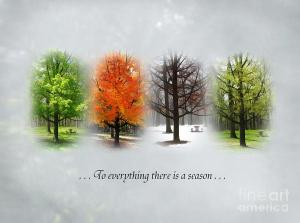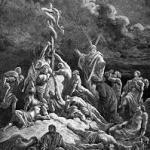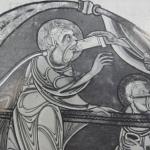Yesterday I had a very encouraging conversation with an editor from a publishing company who has expressed strong interest in one of my two sabbatical book projects: For Everything There is a Season: An Outsider’s Journey through the Liturgical Year. Keep your fingers crossed–if everything works out in the best way possible, this might actually be in print this year. For today’s post, here is a shortened version of the proposed introduction to that book (the whole introduction is about twice as long). Let me know what you think!
One sunny morning in September 1983, when I was struggling in my late twenties with serious financial problems, a failing marriage, years of graduate school ahead of me, and a general malaise both spiritual and physical, I wandered into a Sunday morning service at Saint Matthew’s Episcopal Cathedral in Laramie, Wyoming. In a rush of emotional response to the beautiful organ, the stately procession of choir, crucifer, deacon, and priest from back to front, and the overwhelming expressions of welcome from dozens of strangers, I felt that I had stumbled into a home whose existence I had not been aware of but for which I had been longing my whole life.
Over the succeeding weeks and months Saint Matthew’s became a life-preserver in more ways than one—no wonder I jumped into the strange and wonderful world of all things Episcopalian and the liturgical calendar with the enthusiasm and abandon of a true convert. My enthusiasm and commitment deepened as I experienced Advent for the first time, as Christmas liturgies framed the holidays, and as Epiphany revealed Jesus’ coming out party and early ministry in new ways. Saint Matthew’s became a haven and refuge; before long I was a daily regular at morning prayer services in the side chapel. Other than on Wednesdays when the Dean showed up so we could celebrate eucharist, the responsibility for the daily services rotated through the dozen or so regular attendees.
As is always the case with anyone who is an academic at heart upon discovering something new, I dove with abandon into researching and finding out everything I could about all things Episcopalian. As fate would have it, I came to the Episcopal church just as a new hymnbook (1982) and a new Book of Common Prayer (1979) had been approved and recently disseminated to congregations. Since each book was the first significantly revised and updated version in at least four decades everyone, even the Dean of the cathedral, was more or less at square one as new and unfamiliar hymns as well as a seemingly endless variety of new possibilities for liturgies were suddenly available.
What exactly was it about liturgical worship that seduced me so thoroughly? Since liturgical worship is framed by texts from the Jewish scriptures and the New Testament, the answers to that question begin with a description of my religious background and upbringing and how that upbringing shaped my relationship with sacred texts . . .
Stories and Rhythms
Although I was raised to revere the Bible, a reverence that bordered on worship, it wasn’t until I encountered liturgical worship that is shaped by selected lectionary readings that I came to fully appreciate and love the Bible in its totality. In my experience, those who treat the Bible as essentially the fourth member of the Trinity tend to be very selective in the portions that they emphasize, tending equally to deemphasize or completely ignore obviously contradictory or stubbornly obscure passages.
In the lectionary readings that ground liturgical worship, no portions of scripture are considered too problematic or unimportant for public display. In a given Sunday gospel reading Jesus is as likely to call a foreign woman a dog or speak dismissively to his mother as he is to tell a compelling parable or raise someone from the dead. The depressing psalms get as much play as the joyful ones. The prophets rage about how disappointingly disobedient the people of Israel are while also promising God’s continuing protection and love, despite appearances. God acts like a toddler in one passage and as a wise and beloved parent in the next.
Simply listening and attending to what is read from the lectern for a year of Sundays exposes one to an inexhaustible range of possibilities about the relationship between human beings and what is greater than us. The whole range of human emotions and commitments is on display, most often packaged within stories. And this makes sense, since as Alasdair MacIntrye wrote, human beings are “story-telling animals.” Stories are the natural context within which human beings understand themselves and each other; it is no surprise that Jesus was an incurable storyteller (more on that in a later chapter).
It is also no surprise that both ancient and contemporary people frame their speculations about and expectations of what is greater than us in stories. In the Preface to The Gates of the Forest, Elie Wiesel tells an old Hasidic tale in which a series of rabbinical leaders each sought to follow a three-step ritual for accomplishing the rescue of his respective community through a miracle. The founder of the tradition was Rabbi Israel Baal Shem-Tovand; the three steps were to go to a specific area of a forest to meditate, say a specific prayer, and light a fire. Unfortunately, each of the subsequent leaders in turn forgot a step of the ritual that had been passed on to him. Maggid of Mezeritch remembered two of the three steps, Rabbi Moshe-leib of Sasov knew one of the two steps passed on to him, but Rabbi Israel of Rizhin couldn’t even remember the single step that he had been given. The rabbi confesses to a young listener that he’s old, his memory is failing him, and all he can do is tell stories. But, the rabbi concludes, “It is sufficient. For God made man because He loves stories.” Just remembering the story about the tradition was, as the rabbi hoped, sufficient for obtaining the needed miracle.
The lectionary readings are selected to mirror the rhythms of the liturgical calendar; these rhythms reflect the natural human orientation to both change and stability just as the texts resonate with our natural attunement to stories and narratives. The change of seasons, birth and death, what the ancients used to call “generation and corruption”—within definitive and stable parameters, things are constantly and cyclically changing.
I am a native New Englander who has spent close to half of a century in the Northeast, living first in Vermont in my youth then in Rhode Island for the past three decades. Although I love autumn the most, I would not trade the change of seasons even for a guarantee of twelve months of perfect autumn weather. My vocation as a college professor is shaped by a different calendar that has its own changes—an academic liturgy, if you will.
Pick a date in any month and I will tell you roughly what I’ll be doing with reference to my work. October 20th? Midterm grades will be due within a few days. First week of March? Time for spring break. Third week of September? The first major student written work of the fall semester will be due. The day after MLK day in January? That’s the first day of the spring semester.
The same is true in the liturgical year. Second Sunday of Advent? John the Baptist is on tap. Last Sunday before Palm Sunday? Lazarus gets raised from the dead again. First Sunday after Easter? It’s time for Doubting Thomas. These and other reliably stable points of reference give shape and consistency to various aspects of lives, lives that we live in a world that might otherwise seem either incoherent in its waves of change or suffocatingly boring in its monotony.
The stories and rhythms of the liturgical year will become more and more apparent as we proceed. First, though, it is important to take a first look at the lay of the land that we will be exploring . . .
A Caveat
Whether one is attracted to liturgical frameworks in worship or not, it is worthwhile to consider for a moment that however worship is organized, the structures (or lack of same) are human made and don’t necessarily tell us anything about what is greater than us. This is particularly important when arguing and debating about which forms of worship are best, a hill that it often seems Christians (and other persons of faith) are willing to die on. Annie Dillard writes memorably about this and related issues in Holy the Firm:
On the whole, I do not find Christians, outside of the catacombs, sufficiently sensible of conditions. Does anyone have the foggiest idea what sort of power we so blithely invoke? . . . It is madness to wear ladies’ straw hats and velvet hats to church; we should all be wearing crash helmets. Ushers should issue life preservers and signal flares; they should lash us to our pews. For the sleeping god may wake someday and take offense, or the waking god may draw us out to where we can never return . . .
I often think of the set pieces of liturgy as certain words which people have successfully addressed to God without their getting killed. In the high churches, they saunter through the liturgy like Mohawks, moving along a strand of scaffolding, who have long since forgotten their danger. If God were to blast such a service to bits, the congregation would be, I believe, genuinely shocked. But in the low churches, you expect it any minute. This is the beginning of wisdom.
For any person of faith, it is important to remember that, first and foremost, God is mystery. Our forms of worship, no matter how attractive and satisfying both emotionally and intellectually, are at best revisable human attempts to shape the remarkable possibility that, out of love, God seeks relationship with humans into some sort of provisional story and framework. With that in mind, Advent calls.













